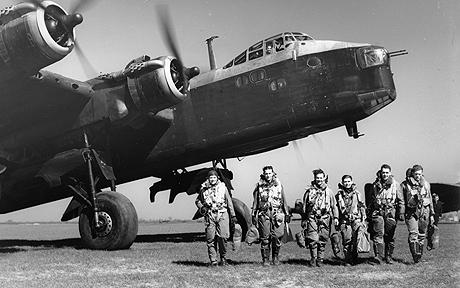The 90 Sqdn left from Wratting Common at 1943-08-24 at 20:37. Loc or duty Berlin
He flew with a Short Stirling (type III, serial EH937, code WP-S).
Campaign report of the USAAF:
(Eighth Air Force):: VIII Bomber Command Mission 86 Part I: An air depot and airfields in France are targetted: 1. 110 B-17's are dispatched to the Villacoublay Air Depot; 86 hit the target at 1800-1805 hours; they claim 1-0-1 Luftwaffe aircraft; 64 aircraft are damaged; casualties are 10 WIA. 2. 42 B-17's are dispatched to the Conches and Evreux/Fauville Airfields; 22 hit the target at 1844-1858 hours; they claim 0-0-2 Luftwaffe aircraft; 1 B-17 is lost and 15 damaged; casualties are 1 KIA and 9 WIA. 3. 35 of 36 B-17's fly a diversion without incident. VIII Bomber Command Mission 86 Part II: 85 B-17's, which had flown to North Africa after attacking Regensburg, Germany on 17 Aug, are dispatched to the Bordeaux/Merignac Airfield; 58 hit the target at 1157-1200 hours; they claim 3-3-10 Luftwaffe aircraft; 3 B-17's are lost, 2 are damaged beyond repair and 40 damaged; casualties are 30 MIA. 9 B-17's returned to North Africa after encountering difficulties. VIII Air Support Command Missions 33A & 33B: B-26's fly 2 diversions for the B-17's.
Campaign report of the RAF:
23/24 August 1943
727 aircraft - 335 Lancasters, 251 Halifaxes, 124 Stirlings, 17 Mosquitos - despatched to Berlin. The Mosquitos were used to mark various points on the route to Berlin in order to help keep the Main Force on the correct track. A Master Bomber was used; he was Wing Commander JE Fauquier, the Commanding Officer of 405 (Canadian) Squadron.
The raid was only partially successful. The Pathfinders were not able to identify the centre of Berlin by H2S and marked an area in the southern outskirts of the city. The Main Force arrived late and many aircraft cut a corner and approached from the south-west instead of using the planned south-south-east approach; this resulted in more bombs falling in open country than would otherwise have been the case. The German defences - both flak and night fighters - were extremely fierce. 56 aircraft - 23 Halifaxes, 17 Lancasters, 16 Stirlings - were lost, 7.9 per cent of the heavy bomber force. This was Bomber Command's greatest loss of aircraft in one night so far in the war.
40 Wellingtons minelaying in the Frisians and off Lorient and St Nazaire, 22 OTU sorties. No losses.
24/25 August 1943
8 Mosquitos to Berlin, 66 aircraft minelaying in the Heligoland, Frisian and Texel areas. No aircraft lost.
With thanks to the RAF and USAAF.net!
This record can also be found on the maps of Back to Normandy with Google coordinates. You can find the maps by clicking on this link on this location.
There are several possibilities to investigate the flight records on Back to Normandy. All the flights are plotted on maps, sorted "day by day", "by squadron", "by type aircraft", "by year or month", "by location" and much more! Don't miss this!!!
If you have any information that you want to share, please add your comment at the bottom of this record. Or send your information to [email protected]. This information will be added to the record.
Your photos and your information are very welcome! The young do care and with your help we keep up the good work.



